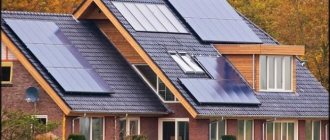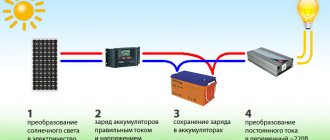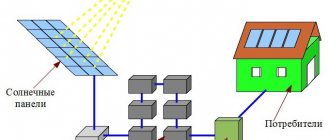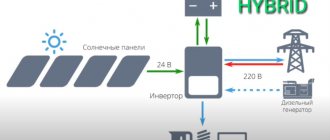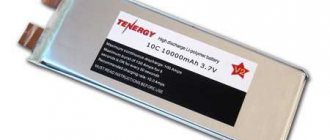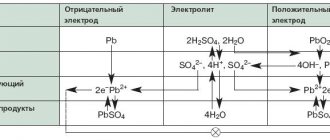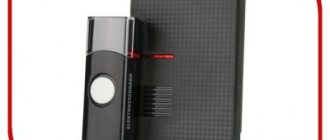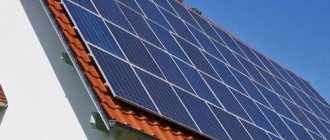Batteries for solar panels are precisely those elements that indicate the main disadvantage of such miniature power plants - the inability to generate electricity in the dark. That is why no owner of an autonomous installation can do without a battery. But the containers are different, and we have to figure out which ones are best suited.
Installing solar panels on the roof is an excellent investment in the future Source krovgid.com
Alkaline batteries
Unlike acid batteries, alkaline batteries cope well with deep discharge and are capable of delivering currents for a long time at approximately 1/10 of the battery capacity. Moreover, it is strongly recommended to completely discharge alkaline batteries to avoid the so-called “memory effect”, which reduces the battery capacity by the amount of the “unselected” charge.
Compared to acid batteries, alkaline batteries have a significant service life of 20 years or more, produce a stable voltage during discharge, are also serviceable (flooded) and maintenance-free (sealed), and seem to be simply designed for solar energy. Actually no, because they are not able to charge with the weak currents that solar panels generate. Low current flows freely through an alkaline battery without filling the battery. Therefore, alas, the destiny of alkaline batteries in autonomous power systems is to serve as a “bank” for diesel generators, where this type of storage is simply irreplaceable.
conclusions
By all criteria, except price, Li-ion batteries are superior to lead-acid models. And even in price they win, considering the number of work cycles. If you choose between different types of lithium-ion batteries, lithium iron phosphate batteries are recognized as the best today. They are leaders in safety criteria, performance parameters, and service life. The main thing is to buy high quality batteries that exactly match the declared characteristics.
VirtusTec produces high-quality energy storage devices, including lithium iron phosphate batteries. At an affordable price, our products have excellent performance characteristics, are reliable and have a long service life. We design and assemble custom-made batteries with any characteristics for the implementation of various tasks, including the efficient operation of home and industrial power plants using solar batteries.
Lithium-ion batteries
Batteries of this type have a fundamentally different chemistry than batteries for tablets and laptops, and use the lithium iron phosphate reaction (LiFePo4). They charge very quickly, can deliver up to 80% charge, and do not lose capacity due to incomplete charging or long-term storage in a discharged state. The batteries can withstand 3,000 cycles, have a service life of up to 20 years, and are produced in Russia. The most expensive of all, but in comparison with, for example, acidic ones, they have twice the capacity per unit of weight, that is, they will need half as much.
Rules for using the device
By adhering to certain operating rules, you can extend the life of your batteries.
By following the rules you can extend the life of your solar battery.
Temperature is one of the most important conditions for good and long-term operation of the device. Sudden changes negatively affect the condition of the batteries. On average, the device should operate at an air temperature no higher than +40° and no lower than -25° C. It is necessary to prevent direct sunlight from entering the device.
To avoid problems such as unintentional heating or spontaneous combustion, batteries should not be placed near open flames. Also, make sure that the devices are not exposed to water or precipitation, which is why there is a high probability of a self-charging current.
Charging batteries must be carried out strictly according to the instructions provided by the manufacturer. It would also be a good idea to regularly check the electrolyte density.
Main technical characteristics of the battery
The characteristics and requirements for batteries are determined based on the operating characteristics of the solar power plant itself.
Batteries must:
- be designed for a large number of charge-discharge cycles without significant loss of capacity;
- have low self-discharge;
- maintain performance at low and high temperatures.
The key characteristics are considered to be:
- battery capacity;
- speed of full charge and permissible discharge;
- conditions and service life;
- weight and dimensions.
Model overview
The following companies produce batteries for solar power plants:
- German company Bosh, engaged in the production of household and industrial equipment.
- German company Sonnenschein, engaged in the development and production of equipment.
- English company YUASA (Great Britain).
- American company C&D Technologies.
- Chinese manufacturer of Delta equipment.
- Chinese company Haza (China).
- Taiwanese company APS.
All of the companies presented above, which have managed to establish themselves in the market very well, are engaged in the production of batteries for solar panels. The products of each company have their own characteristics. For example, batteries produced by Haza are manufactured using AGM and HZY technologies.
For stand-alone systems, batteries manufactured using Gel “deep discharge” technology or OPzV technology batteries are best suited. These characteristics correspond to batteries manufactured by Delta.
How to correctly calculate and choose a battery
Calculations are based on simple formulas and tolerances for losses that arise in an autonomous power supply system.
The minimum energy reserve in the batteries must provide the load at night. If from sunset to dawn the total energy consumption is 3 kW/h, then the battery bank must have such a reserve.
The optimal energy supply should cover the daily needs of the facility. If the load is 10 kW/h, then a bank with such a capacity will allow you to “survive” one cloudy day without any problems, and in sunny weather it will not be discharged by more than 20-25%, which is optimal for acid batteries and does not lead to their degradation.
Here we do not consider the power of solar panels and take it for granted that they are able to provide such a charge to the batteries. That is, we make calculations on the energy needs of the object.
The energy reserve in 1 battery with a capacity of 100 Ah and a voltage of 12 V is calculated by the formula: capacity x voltage, that is, 100 x 12 = 1200 watts or 1.2 kWh. Therefore, a hypothetical facility with a nightly consumption of 3 kW/h and a daily consumption of 10 kW/h needs a minimum bank of 3 batteries and an optimal bank of 10. But this is ideal, because allowances for losses and equipment features must be taken into account.
Where is energy lost:
50% is the permissible level of discharge of conventional acid batteries, so if the bank is built on them, then there should be twice as many batteries as a simple mathematical calculation shows. Batteries optimized for deep discharge can be “emptied” by 70-80%, that is, the bank capacity should be 20-30% higher than the calculated one.
80% is the average efficiency of an acid battery , which, due to its features, releases energy 20% less than it stores. The higher the charge and discharge currents, the lower the efficiency. For example, if you connect a 2 kW electric iron to a 200Ah battery through an inverter, the discharge current will be about 250A, and the efficiency will drop to 40%. Which again leads to the need to double the capacity of a bank built on acid batteries.
80-90% is the average efficiency of an inverter , which converts direct voltage into alternating voltage 220 V for a household network. Taking into account energy losses, even in the best batteries, the total losses will be approximately 40%, that is, even when using OPzS and especially AGM batteries, the capacity reserve should be 40% higher than calculated.
80% is the efficiency of the PWM charge controller, that is, solar panels are physically unable to transfer to the batteries more than 80% of the energy generated on an ideal sunny day and at maximum rated power. Therefore, it is better to use more expensive MPPT controllers, which ensure the efficiency of solar panels up to almost 100%, or increase the battery bank and, accordingly, the area of solar panels by another 20%.
All these factors must be taken into account in the calculations, depending on what components are used in the solar generation system.
Why are batteries needed in solar power systems?
Since solar radiation is not a constant value and, if you are not connected to the central power grid or the connection is not stable, it is not enough to just have solar panels. You need somewhere to store energy and having reliable batteries will help you store the electricity your solar panels produce throughout the day.
The question of “which battery to choose for solar panels” must be approached extremely seriously in order to use your system in working condition at any time of the day. With the wrong battery bank, you will only be able to take advantage of solar energy when the solar panels are producing it, and when the sun goes down, the batteries may not be able to produce the required power. Without good batteries, you'll have to contend with running out of power, especially if the power grid is intermittent or non-existent.
To put it simply, solar batteries can be called intermediaries. They transfer the resulting electrical power to the end consumer.
Everything ingenious is simple: the solar battery produces maximum electrical energy during intense light irradiation, i.e. during the day. However, most often it is used in the evening, when household appliances are running.
To make it possible to use solar energy when the sun no longer shines, people came up with batteries for solar panels. With their help, excess energy that was generated during the day is preserved in order to be able to use it at night.
Any electric battery provides a reusable constant current with the ability to perform reversible chemical processes. This occurs during multiple charge cycles, when an electric current is passed in the direction opposite to the reverse movement of elementary particles during discharge.
Battery operating rules
Maintenance batteries emit gases during operation, so placing them in residential premises is prohibited and a separate room with active ventilation must be equipped.
The electrolyte level and charge depth must be constantly monitored to avoid battery failure.
For year-round operation, in order to avoid deep discharge of batteries on cloudy days, it is necessary to provide for the possibility of recharging them from external sources - the network or a generator. Many inverter models can implement such switching automatically.
Features of operation
You need to choose the battery connection diagram very carefully. In some cases, an unsuccessfully selected circuit can cause an imbalance of devices relative to charge levels. This can significantly reduce their service life. Battery pooling requires additional devices such as a controller and an inverter.
The controller monitors the battery charge level. When creating a battery pack, jumpers are installed to equalize the charge level. In addition to these elements, for uniform charging and discharging cycles, it is best to use identical battery models from the same manufacturer.
The solar energy with the help of panels undergoes the process of conversion into constant current. Electrical appliances consume different amounts of power. The inverter is designed to convert a constant current value into a varying value to ensure the full functioning of all electrical appliances.
Brief summary
To correctly calculate the capacity of a battery bank, you need to determine the daily energy consumption, add 40% of the fatal losses in the battery and inverter, and then increase the calculated power depending on the type of batteries and controller.
If solar generation will be used in winter, then the final capacity of the bank must be increased by another 50% and the possibility of recharging the batteries from third-party sources - the network or a generator, that is, with high currents must be provided. This will also influence the choice of batteries with certain characteristics.
If you find it difficult to make your own calculations or want to make sure they are correct, contact the specialists of Energy Center LLC - this can be done via online chat on the With Light website or by calling. We have extensive experience in completing and installing solar generation systems at various facilities - from cottages and country houses to industrial and agricultural facilities.
Manufacturers offer such a wide range of equipment that it is not difficult to assemble a solar power plant according to your requirements and financial capabilities.
Which ones to take?
In fact, batteries are the main brake on the development of alternative energy in general, its weak side. Modern technology has not made batteries smaller, lighter or cheaper. In relation to a solar power supply system, two types of batteries are used:
- Acidic;
- Gel.
There is a difference in price and internal structure, but the biggest difference is in efficiency. A gel battery tolerates deep discharge much better; this is the normal operating mode for it. The disadvantages of gel batteries include low starting currents at sub-zero temperatures, although such currents will not be needed when used in the home power supply system. Also, gel batteries are much more expensive.
Optimal temperature conditions
Any batteries tolerate sudden temperature changes extremely negatively, this applies to those cases when the temperature exceeds +45 ˚С or drops to -20 ˚С. Due to the fact that the panels can be subject to sudden heating and even spontaneous combustion, they are strictly prohibited from being kept near an open flame. It is worth noting that getting any precipitation or ordinary running water onto the battery is simply unacceptable, since self-discharge currents may occur, which are triggered by additional electrical circuits.
Experts are accustomed to distinguishing batteries for solar panels by type of housing design:
- Hermetic models using a closed cycle. They can be low-maintenance (require constant monitoring and topping up with distilled water), as well as maintenance-free (highly sensitive to overcharge and deep discharge).
- Requiring constant monitoring of the level of electricity and its constant restoration when vapors boil off.
Operating Parameters
Before purchasing a battery for solar panels, you need to familiarize yourself with all the operational nuances. This is due to the fact that only a properly selected battery can ensure reliable operation of the entire system. The main indicators are:
- Energy density level.
- Battery capacity.
- Type.
- Temperature regime.
- Self-discharge ability.
Experts determine the battery capacity by the amount of charge, which is measured during the process of discharging energy to end consumers.
The International System of Units is widely used for technical measurements. But in the CIS countries there has long been a tradition of determining the battery capacity in amperes per hour. To compare the existing design features of different units as accurately as possible, energy density is used. In this case, the total amount of energy that is distributed per unit volume of the battery must be taken into account. We recommend: Laptop battery repair, restoration and restoration Regarding self-discharge, this function is used to conduct an accurate analysis of charge loss when the system is idling. This term was first introduced by specialists to assess the quality of operation of a particular installation when it was necessary to achieve long-term energy storage. You should always remember that if the battery is stored in a room where the air temperature exceeds +40 ˚C, then after a few months there will be a loss of capacity by 40-50%.
Optimal location
12V solar batteries for charging a car battery, like solar batteries for tourists, require for normal operation the presence of the sun and a well-chosen position in which the light flux falls perpendicularly to the entire surface of the photosensitive elements. With large panels that allow you to get the maximum effect from charging, device placement becomes a noticeable problem.
If we are talking about parking, especially in field conditions, then the issue is resolved quite simply. However, if it is necessary to recharge while driving, installing a solar panel in a car to charge the battery becomes a rather complex task, the solution of which is partly proposed by installation manufacturers. They make special stands that allow you to place the panel in a position convenient for receiving sunlight.
The solar charger for a car battery is inserted into a special socket on a rod, which can be fixed at a certain angle to the horizon. When turning towards the sun and choosing the optimal inclination, the working surface receives a luminous flux of maximum strength.
Unfortunately, such support structures are most often attached to low-power devices. More efficient panels have a larger area when unfolded , and manufacturers leave it to car owners to decide on their own the issue of optimal placement of installations.
Two options are considered the most convenient:
- Placing panels on the roof of the cabin.
- Laying on the upper plane of the dashboard.
Both options have their advantages and disadvantages, so we should talk about them separately.
Dashboard
The upper plane of the dashboard is convenient for placing a solar panel of a suitable size. The device is located inside the cabin , which provides it with protection from atmospheric manifestations or attacks by dishonest citizens.
An additional convenience is the ability to connect to the cigarette lighter or corresponding terminals, which is much more convenient than when installing panels on the roof, where the wires are a small problem. You can charge the battery both while parked and while driving without taking additional measures to securely secure the device.
The disadvantage is the limited area of the panel , which does not allow full charging of the battery. A conventional solar panel requires a larger area to charge a car battery, and only an additional panel can be installed on the dashboard to recharge the battery to a certain level.
Another disadvantage is the ability to obtain effective solar flux only in a certain direction of movement or position of the car when parked. If the direction of movement does not coincide with the position of the sun, the efficiency of the panels drops sharply. Despite manufacturers' claims of ability to work in cloudy weather, the device noticeably loses performance when access to direct light is limited .
Car roof
The outer surface of the cabin roof has a fairly large area and is located in such a way that the sun's rays constantly fall on it. This allows you to place a solar panel on it with a total area of 1 m2, and even more, which provides enough energy to fully charge a car battery even after a deep discharge. A solar charger for a 12 v car battery, with a power of 30-60 W sufficient for this purpose, needs exactly this area.
The disadvantage of this option is the need to somehow fix the panels on the roof , since they are relatively light in weight and can be moved or thrown off by a normal gust of wind. When moving, the problem increases many times over, since the oncoming air flow creates significant pressure and can tear off the panels. While driving, there is a risk of not immediately noticing this moment, which will force you to turn around and go in search.
In addition, photosensitive elements located on the roof of a car in urban environments can easily become prey for antisocial individuals, which also complicates installation in this convenient, but too open place.

